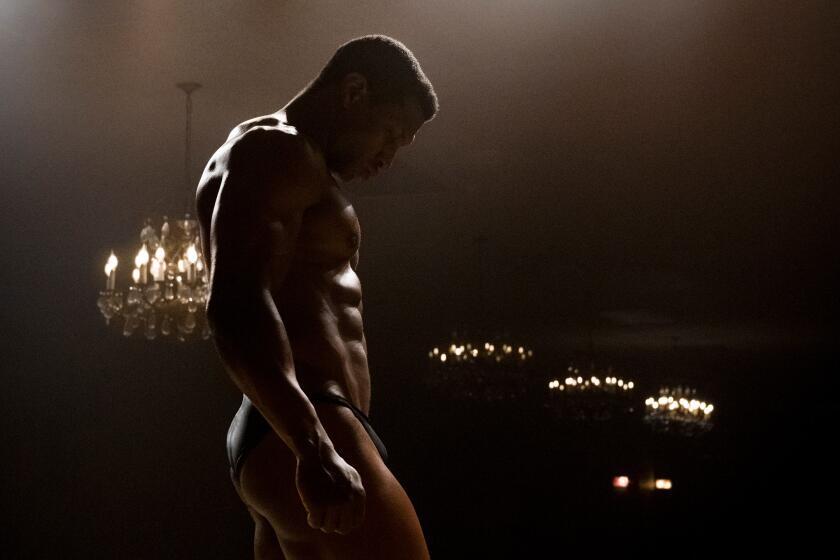Hollywood Knows Fakin’, Not Racin’
- Share via
At a crucial moment in the Tom Cruise stock car racing movie “Days of Thunder,” Robert Duvall’s gnarled crew chief Harold Hogge tells Cruise’s cocky, bone-headed young Cole Trickle that if he expects to win against the good ol’ boys on the high banks of the Southern ovals, he’s got to go out there and swap paint with them. When they hit you, hit ‘em back.
“It’s called rubbin’, and rubbin’, son, is racin’,” Duvall drawls.
There ensues some of the most hellish fender bendin’, paint swappin’, wall scrubbin’ auto racin’ ever put on film, and although that footage has drawn praise even from critics who saw the nonsense in the movie’s off-track drama, knowledgeable racing fans know it for what it is: It’s called fakin’, and fakin’, son, is Hollywood.
For all its flashy quick-editing, telephoto close-ups and middle-of-the-action views, the racing backdrop in “Days of Thunder” is about as authentic as the rear-projection mayhem that Mickey Rooney tooled his vintage Indy car through in the 1949 “The Big Wheel.”
Yes, “Thunder” used real stock cars driven by real drivers in real races for some scenes, but the contrast provided by the actual footage undermines the credibility of the story’s choreographed action. Stock cars going around a banked oval at 200 miles an hour are airplanes without wings, held onto the track by aerodynamic and centrifugal forces. Anybody who has watched five minutes of a major stock car race on television in recent years, and seen through the eyes of car-mounted TV cameras how fast these 4,000-pound slabs are really moving, knows you can’t suddenly turn right or left into another car--as drivers do throughout “Days of Thunder”--and keep going.
The “grudge match” is a staple of Hollywood sports films. Good guys, bad guys, you need the conflict. And certainly grudges are part of real racing. Richard Petty and Bobby Allison used to wage war on the track, and when they were just starting out, Bobby Allison and his younger brother Donnie got so mad at each other in one race, they stopped their cars 100 yards from the finish line and began rubbin’ each other with their fists. But these grudges were conducted on “short tracks” where speeds were slow enough to allow survival. Get out of your car at Daytona and the skid mark between your shoes and your helmet will be about a mile long.
Sports films often patronize the sports that inspire them, but auto racing seems particularly vulnerable. So many filmmakers are both vicarious thrill-seekers and born liars; it’s a numbing combination when they take on something that is already on the edge. They are so fascinated by whatever it is that drives men to the brink of real disaster--as opposed to, say, going over budget--that they can only assume it is some sort of deep-set death wish or unresolved childhood trauma.
Naturally, those romantic notions often spill into the lives of the filmmakers. Steve McQueen was already a motorcycle racer before doing “Le Mans” in 1971 but attempted more serious racing afterward. James Garner got the bug after doing “Grand Prix” in 1966. Paul Newman felt the need for speed after doing “Winning” in 1967, and has enjoyed an active, injury-free semi-professional racing career in the years since. If he has a death wish, he hasn’t driven it into a wall yet.
Cruise, introduced to the sport through Newman when they were doing “The Color of Money,” had been in celebrity races before “Days of Thunder” was conceived. In fact, he shares the story credit with Robert Towne, a Mutt and Jeff Hollywood literary partnership if there ever was one.
So, if Cruise was simpatico with stock car racing and its nuances, why did he allow himself to play so ridiculous a character in such ridiculous situations in “Days of Thunder”? And if Robert Towne is so great at creating authentic mood and atmosphere, why is the film a pastiche of cliches and antiquated myths? The last time somebody built a Daytona 500 winner in a wooden barn, with dusty streaks of sunlight pouring through cracks in the pine-wood walls, there was a sour-mash still sitting just a few feet away. For the last 30 years or so, winning stock cars have been built in high-tech garages with specially built parts shipped in from Detroit.
Superficially, “Days of Thunder” captures some of the color and spectacle of modern stock car racing. We see the infields fill up at Darlington and Charlotte with motor homes and shirtless rednecks; we see fields of brightly colored cars thunder down the back straight and dip into the tri-oval at Daytona; we see frantic pit crews changing tires and waving their drivers back onto the track.
But from the first scene with Cole Trickle--when he arrives James Dean-style on a motorcycle, goes faster in the Daytona champion’s car than the champ himself, and then announces that he will win next year’s Daytona 500--we know we’re heading down a road that’s about as hard to follow as a circular race track. Who needs Robert Towne? You could wake up any stud on the infield, promise him a six-pack and he’d write the same third act.
The difference is, he’d never believe you’d buy it.
More to Read
Only good movies
Get the Indie Focus newsletter, Mark Olsen's weekly guide to the world of cinema.
You may occasionally receive promotional content from the Los Angeles Times.










